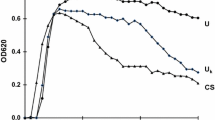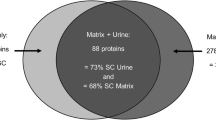Summary
The nature of the soluble stone matrix and its possible role in urinary stone formation was studied. For this purpose we performed two-dimensional cellulose acetate membrane electrophoresis of the glycosaminoglycans (GAGs) which were contained in the soluble stone matrix, substances adsorbed onto calcium oxalate crystals in vitro (crystal surface binding substances, CSBS) and urinary macromolecules (UMMs). The main GAG in the soluble stone matrix and CSBS was found to be heparan sulfate, whereas the UMMs contained various GAGs usually seen in urine. An inhibition assay showed the soluble stone matrix to have the strongest inhibitory activity among these macromolecular substances when inhibitory activity was expressed in terms of uronic acid concentration. It is suggested that the main GAG in the soluble stone matrix consists of heparan sulfate, which has a strong inhibitory activity on calcium oxalate crystal growth and aggregation and constitutes part of the CSBS.
Similar content being viewed by others
References
Angell AH, Resnick MI (1989) Surface interaction between glycosaminoglycans and calcium oxalate. J Urol 141:1255
Bitter T, Muir HM (1962) A modified uronic acid calbazole reaction. Anal Biochem 4:330
Boyce WH (1968) Organic matrix of human urinary concretions. Am J Med 45:673
Bowyer RC, Brockis JG, McCulloch RK (1979) Glycosaminoglycans as inhibitors of calcium oxalate crystal growth and aggregation. Clin Chim Acta 95:23
Bradford MM (1976) A rapid and sensitive method for the quantitation of microgram quantities of protein utilizing the principle of protein-dye binding. Anal Biochem 72:248
Doyle IR, Ryall RL, Marshall VR (1991) Crystal matrix protein: an inhibitor of calcium oxalate stone formation? Br J Urol 67:399
Finlayson B, Vermeulen CW, Stewart EJ (1961) Stone matrix and mucoprotein from urine. J Urol 86:355
Gjaldbaek JC, Robertson WA (1980) Does urine from stone-formers contain macromolecules which promote the crystal growth rate of calcium oxalate crystals in vitro? Clin Chim Acta 108:75
Hata R, Nagai Y (1972) A rapid and micromethod for separation of acidic glycosaminoglycans by two-dimensional electrophoresis. Anal Biochem 45:462
Koide T, Takemoto M, Itatani H, Takaha M, Sonoda T (1981) Urinary macromolecular substances as natural inhibitors of calcium oxalate crystal aggregation. Invest Urol 18:382
Koide T, Yoshioka T, Yamaguchi S, Hosokawa S, Utsunomiya M, Sonoda T (1990) Urinary crystal surface binding substances on calcium oxalate crystals. Urol Res 18:387
Morse RM, Resnick MI (1988) A new approach to the study of urinary macromolecules as a participant in calcium oxalate crystallization. J Urol 139:869
Murphy BT, Pyrah LM (1962) The composition, structure, and mechanisms of the formation of urinary calculi. Br J Urol 34:129
Nakagawa Y, Ahmed M-A, Hall SL, Daganello S, Coe FL (1987) Isolation from human calcium oxalate renal stones of nephrocalcin, a glycoprotein inhibitor of calcium oxalate crystal growth. J Clin Invest 79:1782
Nishio S, Abe Y, Wakatsuki A, Iwata H, Ochi K, Takeuchi M, Matsumoto A (1985) Matrix glycosaminoglycans in urinary stones. J Urol 134:503
Resnick MI, Sorrell ME, Bailey JA, Boyce WH (1982) Inhibitory effect of urinary calcium-binding substrances on calcium oxalate crystallization. J Urol 127:568
Roberts SD, Resnick MI (1986) Glycosaminoglycan content of stone matrix. J Urol 135:1078
Robertson WG, Peacock M, Nordin BEC (1973) Inhibitors of the growth and aggregation of calcium oxalate crystals in vitro. Clin Chim Acta 43:31
Sallis JD, Lumley MF (1979) On the possible role of glycosaminoglycans as natural inhibitors of calcium oxalate stones. Invest Urol 16:296
Scurr DS, Bridge CM, Robertson WG (1980) Studies on inhibitors and promoters of the crystallization of calcium oxalate in urine and in matrix from calcium oxalate stones. In: Smith LH, Robertson WG, Finlayson B (eds) Urolithiasis. Plenum Press, New York, p 601
Vermeulen OW, Lyon ES (1968) Mechanism of genesis and growth of calculi. Am J Med 45:684
Author information
Authors and Affiliations
Rights and permissions
About this article
Cite this article
Yamaguchi, S., Yoshioka, T., Utsunomiya, M. et al. Heparan sulfate in the stone matrix and its inhibitory effect on calcium oxalate crystallization. Urol. Res. 21, 187–192 (1993). https://doi.org/10.1007/BF00590035
Received:
Accepted:
Issue Date:
DOI: https://doi.org/10.1007/BF00590035




